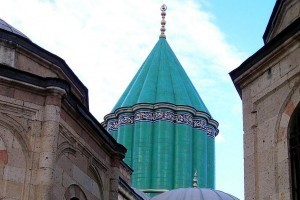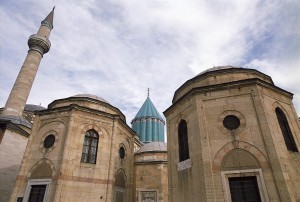How I Met Rumi
First, a confession. Though I’m about to publish a new book, DAMASCENA: the tale of roses and Rumi, I had no idea who Rumi was when I sat at his tomb in 1998. I had never heard of Rumi. I was doing research for my first novel about a famous Turkish rug weaver, The Virgin’s Knot, which sent me on a wild journey through Turkey to learn about rug weaving, Turkish folklore and culture. So why wasn’t Rumi on the radar?
I was raised in a Lutheran church in Amish Country, south central Pennsylvania, a mostly German culture. We ate giant soft pretzels, not pita bread (at least until the late 80s). In school, we studied English poets, not the work of a man who lived nearly 800 years ago in medieval Persia. What I heard about was Turkey.

Mevlana Monastery of the Sufi Dervish order, Konya, Turkey
I wanted to go ever since my oldest best friend fell in love with Istanbul. I craved a direct experience in the fabled city of flying carpets, fig trees and sultans. Mostly, I wanted an adventure that didn’t put me in the hospital like the one where I was struck by a drunken driver shortly after college. I needed something fun that could also push my edges. In the spirit of Thoreau, I wanted to ‘stand up to live’ before I sat down to write. Traveling to exotic lands seemed like a good choice. Something about traveling alone, in my mid-20s, as a young woman in the Middle East, seemed as close as I could get to working as a foreign correspondent. Even if I was gathering research for a historical novel, the journalist in me refused to quit.
I was sobered by my experience in Konya. I lived with Mehmet Ucar and his family for a week. Mehmet is the self-made, beloved rug merchant of Konya, who grew up in a village in the Taurus mountains. He built himself quite a reputation with his shop, Ipek Yolu (Silk Road), and the rugs he acquired and sold over the years. He opened his home and his heart to me, and I loved that his wife wore no headscarf and worked as a nurse in the local hospital. His two young daughters had short hair and played soccer, while they lived next door to aunts and uncles who looked straight out of a description from Freya Stark’s books. Billowing cotton pantaloons, long skirts, tunics and vests. Bright headscarves framing joyful faces. Mehmet seemed to be the bridge between generations of women, supporting the tradition of rug weaving while rallying his wife and daughters to demystify traditional roles assigned to Muslim women—especially in Konya, Turkey’s most conservative city.
Mehmet sat me down one afternoon in a small, square, dusty shop made of turquoise aluminum where he stored colorful skeins of wool. We spoke of life. My accident. Recovering. Finding ‘my man.’ He said, “You are like daughter to me. Love is not between the legs. Love is always here,” he said and touched his hand to his heart. The next day, his cousin, Muamar (who would become a character in The Virgin’s Knot along with Mehmet without any name change), took me to the largest building in Konya. We had passed it several times already. I knew it was a mosque. I saw all the shoes lined up outside the building and men entering, carrying rolled up prayer rugs on their shoulders. I didn’t think I’d have a chance to enter, because I was a woman.

Teke (monastery) and Rumi’s tomb, Konya, Turkey
Mumamar, two years my senior, showed me the way. I covered my head with a headscarf and got on my knees on one of hundreds of prayer rugs covering the huge floor. The ceiling was framed inside a massive dome and I swear it felt like the universe could fit inside it. Maybe it did. The next thing I know, Mumamar led me into another building close by and another room, filled with several sarcophagi. “Rumi,” he said, “Is buried here.” His eyes were wide and he stood in deference to the spirits there. I stood speechless and awkward. I didn’t know who Rumi was. I had no clue where I was or what had transpired there.
At the time, I had no context for the man Rumi, his life, his work, or his impact on the world. But I can tell you standing in that room (and writing about it now), gave me chills unlike any I’d experienced in my life. Not spooky chills. Chills that explode through your heart. A current charged the air and a doorway opened for me. It would take nearly a decade for my mind to catch up to the ‘current’ that day and to recognize it as Rumi’s signature energy. As soon as I returned to San Francisco, I got a copy of Coleman Bark’s The Essential Rumi. Studying it and the rare English texts written about Rumi’s life inspired DAMASCENA: the tale of roses and Rumi. Rumi’s presence showed up during the writing in strange, undeniable and inexplicable ways that I will share in the next post.



